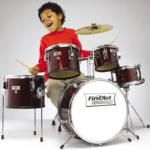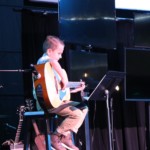Young musicians often start experimenting with emotional expression through music by singing loudly, creating rhythms by banging on tabletops, the backs of car seats, and bouncing on sofas or beds. Amusing and creative, the persistence of these expressions can sometimes distress for parents. What constructive outlet is available to children who want to make loud banging noises?
One potential answer seems almost too simple: the drums.
To provide a child with such an opportunity is to provide them with the tools to develop emotional expression as their own life experiences increase in complexity and nuance. What better representation for a child’s pure energy than a pulsating, heart-like beat? As the student grows, this energy might turn to excitement—the shimmer of a high-hat syncopation. Such is the musician’s emotional expression.
If you believe your child might benefit from drum lessons, the Omaha School of Music and Dance provides lessons in an exceptional room lined with sound-reducing panels, and equipped with two drum kits (one for the student, and one for the teacher). But before one can approach the “kit” and make rhyme or, ahem, rhythm of it, let’s first look at the history and the different parts of the drum set.
Within the western classical music traditions, there was a differentiation between Percussionists and Drummers. Percussionists performed on instruments resonating when struck—that is, hit with a stick or other device. ‘Drummers’ were defined as those who marched in military bands. In this sense, all drummers were percussionists, but not all percussionists were drummers. Within an orchestra, percussionists were lone musicians operating a single piece of equipment. The snare drum player only played the snare drum, one musician played the triangle, one on the bass drum, etc. This meant that the percussion section of an orchestra had a minimum requirement of personnel to play all the instruments in a composition. It also meant a minimum amount of money to hire the musicians, and more space required for equipment—particularly limiting for operations with small budgets, or small performance spaces.
In the mid-19th century, percussionists began experimenting with foot pedals to operate more equipment at once. And so drum “kits” slowly made their debuts in places such as opera “pits” and silent film orchestras where space was limited. The drum kit’s popularity grew exponentially, though, with the advent of the hot new dance-hall music, Jazz. It is from this point on where the drum “set” as we know it, was standardized and mastered in its own right.
The drum kit is made up of four types of equipment:
- Breakables (sticks, cymbals, snare drum, stool, drum pedal)
- Shells (bass drum, toms)
- Extensions (accessories like cowbell, tambourine, triangle, chimes, etc)
- Hardware (cymbal stands, drum stands, pedals)
From these four categories, the kit can be made up from almost any combination of the following equipment:
Bass drum – on the floor, operated by a foot pedal
Floor tom
Snare drum
Hanging tom(s)
Hi hat – cymbal (two cymbals sandwiched, opened and closed by foot pedal)
Crash Cymbal
Ride Cymbal
Splash Cymbal
China Cymbal
Kits are characterized by the number of drums (not accessories or cymbals) in the set: a two-piece set has bass drum, snare, and any accessories; three-piece has bass drum, snare, hanging tom, and any additional cymbals; etc.
These drum sets are what one most often hears in Jazz and Rock from the 20th century onwards. Drum sets have become the standard percussion equipment in almost any ensemble outside of the classical orchestra.
From the enthusiastic beginner, to the teenager auditioning for Drum and Bugle corps, we have teachers to instruct all levels and ages. The Omaha School of Music and Dance offers single- and month-long trial lessons for drums, as well as a new audition-preparation course. Visit our website, or call (402) 515-9639 to register for drum lessons today!



